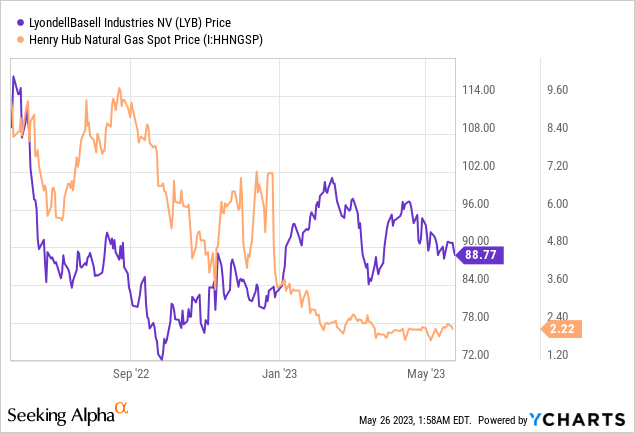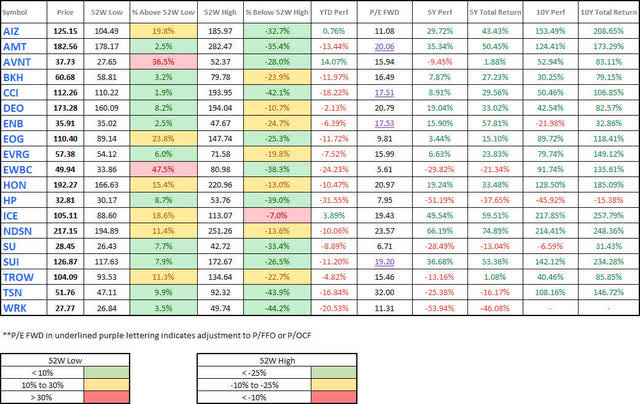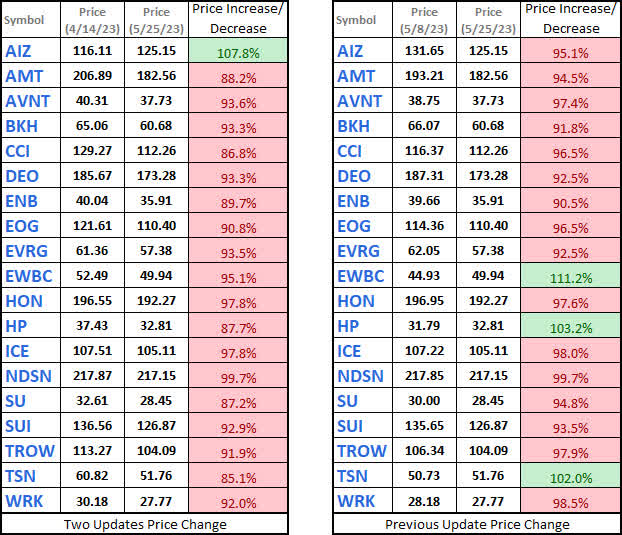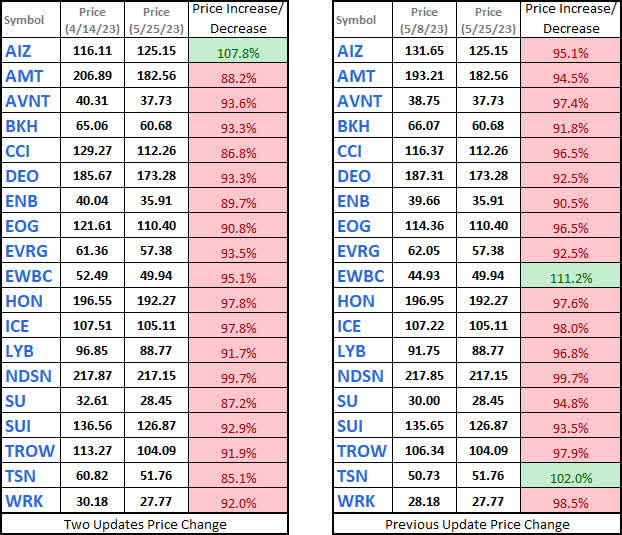The market is anything but predictable.
The Watchlist consists of companies that look interesting for one reason or another. In most cases, I have a modest familiarity with the company including having read recent quarterly earnings releases and reviewed various investor presentations and annual reports.
Since the last article, we haven’t made any changes to the companies on the watchlist, however, we plan to exchange a few names because there have been some stocks that have become considerably more attractive in a short period of time. The companies we are removing are not necessarily bad picks or unworthy of further consideration but often lack any catalyst that would make them more attractive in the short/medium term.
Eliminating HP From The Watchlist
The following names will not be included in the list in the next update:
Helmerich & Payne
In my previous article, I mentioned that HP was likely on the chopping block. Here is what I said about the company then:
HP’s Q2-2023 was solid coming in at EPS of $1.55/share compared with $.91/share in Q1-2023. Unfortunately, the better-than-expected results for Q2 were overshadowed by “contractual churn, a softer natural gas market”, and “prioritizing of disciplined pricing in the face of wavering industry utilization.” All of this implies that Q2’s results are the peak and that Q3 and Q4 are likely to see results that are much less impressive.
It’s not that HP isn’t attractively priced compared to historical data but there aren’t any catalysts that would result in any meaningful improvement to the current stock price in the short/medium term.
The reason I didn’t remove HP from the last article is that I really didn’t have anything on my radar to replace it with but after the swings of the last two weeks, I think there is opportunity in the following replacement.
Adding LYB To The Watchlist
LyondellBasell (LYB) has been a holding In Jane’s Retirement Accounts for quite some time and the size of the position is a significant chunk of Jane’s portfolio. We recently added more shares and will add even more if the stock price closes in on its $80/share. The stock price has seen significant support around $75/share and has only dropped below that during the start of COVID.
If you are wondering what I find so attractive about LYB is that it provides chemicals that society is dependent on and it has continued to focus on finding ways to make money off of environmentally friendly initiatives that focus on recycling plastics. This is important because as consumers continue to emphasize the importance of wanting products that are environmentally sustainable it will continue to drive the demand for these types of programs.
Another reason for liking LYB is that earnings will benefit from the significant reduction in natural gas prices.

As mentioned above, the historical stock price has seen good support levels at $75/share and the 12th consecutive year of dividend increases also gives support for this level because the stock would be generating a yield of 6.67% which is where its four-year average sits (6.75%) but that is weighted higher because of the large special dividend payment in 2022.
At the current price of $88.77 LYB yields 5.63% after the most recent dividend increase.
Buying And Selling NDSN
Nordson (NDSN) has been growing its position in the portfolio because it has a diversified business model and is growing its dividend and share price in a very compelling way. Even as we remain close to the 52-week-low, the stock has a 10-year total return of 248% which makes it the second-best-performing stock on the watchlist just shy of Intercontinental Exchange’s (ICE) performance of 257%.
We recently sold shares and purchased more because we were able to eliminate the small number of high-cost shares through the use of limit trades.
Watchlist – NDSN Trades (CDI)
We will continue to acquire more shares of NDSN and plan to use the same methods to continue maximizing the number of low costs shares in the position.
Watchlist
All tables below are compiled using Seeking Alpha information under the business name Consistent Dividend Investor (‘CDI’).
The first image represents the short-term and long-term performance of each stock on the list individually. The goal here is that we are looking for companies that are attractively priced relative to historical prices. It is absolutely critical that this only works if you are picking companies that you believe are performing reasonably and are undervalued. Simply put, do not conflate a company’s low stock price (relative to historical pricing) with being undervalued because there are a handful of other indicators like the dividend yield, earnings growth, and debt metrics that must be considered.
Watchlist – Reasonably Priced – 2023-5-25 (CDI)
The table below takes a closer look at the dividend yield, growth, and payout ratio to see if the yield is more/less attractive than its historical average and whether or not growth is sustainable.
Watchlist – Dividend – 2023-5-25 (CDI)
The two metrics below represent the debt metrics that I think are worth knowing for each of the companies on the Watchlist. I am still researching additional debt metrics that I would like to monitor. I have always appreciated the Current Ratio and LT Debt To Total Capital.
Current Ratio – This is a liquidity ratio that focuses on a company’s ability to pay short-term obligations (typically less than 12 months). A current ratio > 1 is a good starting point (because this means the company has enough funds available to pay all obligations for the next year). Companies that operate in different sectors are likely to have very different current ratios. For example, most of the industrial/manufacturing companies on the list have some of the highest current ratios while companies that are infrastructure (REITs and Pipelines) tend to have a lower current ratio figure.
Long-Term Debt To Total Capital Ratio – This ratio is also industry-specific because there are some industries such as pipelines and REITs that naturally rely more heavily on the use of debt while other companies typically use less leverage. This one will be extremely helpful with the challenging market conditions because the higher the amount of leverage used the more likely it is that a company won’t be able to handle its obligations and could go insolvent.
Watchlist – Debt Metrics – 2023-5-25 (CDI)
The last image is slightly different because it includes two separate time frames to look back at. The first image shows how much the price has moved since two updates ago while the second image shows how much the price has moved since the most recent update.
Watchlist – Share Price Comparison – 2023-5-25 (CDI)
Open Trades
Watchlist stocks aren’t the only stocks that interest me but it’s the only list I have that track stocks John and Jane don’t currently have in their portfolio. We use limit trades on a regular basis and the purpose of these trades is dependent on market conditions and potential opportunities. I think it is worth noting that many of these trades never materialize because they expire or I cancel them.
Purchases – If I have a very specific price point for a stock I will set a purchase limit trade and most of these will have execution orders that last for up to six months.
Sales – If you read the monthly updates for John and Jane you will notice occasional limit trades where we have chosen a desired price point to sell shares at. This is especially useful when we are trimming back a high-cost portion of a position to lower John and Jane’s exposure. These also have the same (up to) six-month expiration.
Here are some of the more notable limit trades we have in play. Let me know in the comment section if there are any questions about these trades.
Taxable Account – Open Trades 2023-5-25 (CDI) Jane Traditional IRA – Open Trades 2023-5-25 (CDI) Jane Roth IRA – Open Trades 2023-5-25 (CDI) John Traditional IRA – Open Trades 2023-5-25 (CDI) John Roth IRA – Open Trades 2023-5-25 (CDI)




Conclusion
Interestingly enough, HP was the only company on the watchlist that did not have a positive 10Y Total Return.
The list below is what the new table showing price differences from article to article would have looked like with HP removed and LYB added to the table.
Watchlist – Share Price Comparison – 2023-5-25 (LYB Added) (CDI)
Like most of the other names on the list, LYB has become more attractive in recent months but almost every metric indicates that the company is executing well, and the vote of confidence by increasing the dividend for the 12th straight year seals the deal.
Previous Articles
April Watchlist: Adding Tyson Foods To The List And Trade Updates
Undervalued Dividend Stocks Watchlist – May 8th Update
John and Jane are currently long on the following positions in the watch list: American Tower (AMT), Avient (AVNT), Crown Castle (CCI), Enbridge (ENB), EOG Resources (EOG), East West Bancorp (EWBC), Honeywell (HON), Helmerich & Payne (HP), Intercontinental Exchange (ICE), LyondellBasell (LYB), Nordson (NDSN), Suncor (SU), Sun Communities (SUI), T. Rowe Price (TROW), WestRock Company (WRK).
Editor’s Note: This article discusses one or more securities that do not trade on a major U.S. exchange. Please be aware of the risks associated with these stocks.
Read the full article here











